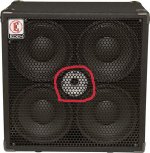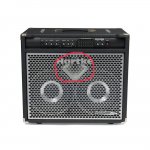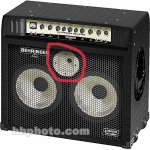Two questions:The highest note on a bass is ~330 Hz (21st fret on the first string).
Question 1: Why do you suppose so many bass guitar amps actually have tweeters, if 330 Hz bandwidth is all you need? Consider that few tweeters operate below 2 kHz, and many only work above 4 kHz, particularly the little horn tweeters that tend to be used on bass guitar amps.
Question 2: Have you ever actually heard the sound of a bass guitar with everything above 330 Hz filtered out?
Fact: because bass guitar pickups are mounted quite near to one end of the strings, and not in the middle (12th fret location), what comes out of the pickup is mostly harmonics, with comparatively little fundamental.
Fact: Some percussive bass-playing styles (slapping, popping) produce large amounts of treble up to several kHz.
Fact: Even with "old school" playing techniques, a good part of the character that differentiates one bass guitar from another comes from harmonics, fretting and fingering noises, etc, that extend up beyond 1 kHz.
Because of all these factors, I would say your estimate of the inductive reactance of a bass guitar pickup is substantially in error, by a factor of at least three to ten times.
In the end, there is a point where further discussion no longer helps to clarify an issue, and then it's time for an actual experiment. If you really want to know how well a 10M pot with a taper resistor works (wasn't it 5M a few posts ago?), buy one, wire it up, get a few people with some good bass guitar chops to try it out. Make sure to use a reasonable length of guitar cable, too, because there is also that little issue of excessive source impedance of the pot to worry about (both J.M. Fahey and I mentioned it in earlier posts).
For what it's worth: a 10M pot will certainly "work", in the sense that some sort of sound will come out of the amp. That was never in question. The question was whether this approach is better than simply using the appropriate log pot chosen by the manufacturer in the first place.
Also for what it's worth: there are situations where using a taper resistor isn't much of a liability. If you wire a 22k taper resistor across a 100k linear pot and feed the thing straight from an opamp, the source impedance is so low that the taper resistor poses no problem. If you feed the signal from the pot to another opamp in buffer or non-inverting configuration, loading effects are also negligible. Under these conditions, there is no penalty for using a linear pot with taper resistor, and it may indeed feel like a smoother curve than some log pots.
-Gnobuddy
P.S. There is a typo in one of the attached file names - that's an "Eden" EX410 bass cab, not an "Edem". Sorry!
Attachments
Thank you for that link, it proves the point very well. 🙂 Though some of those huge impedance peaks occur at frequencies too high to matter - few electric guitar amp speakers will reproduce much over 5 - 6 kHz.Also heres a link to impedance vs freq curves for pickups. They can be quite high.
http://www.ece.rochester.edu/course...oject/Electric_Guitar_Pickup_Measurements.pdf
With bass guitar, it's reasonable to assume a lower upper-frequency limit, and correspondingly less inductive reactance. But, even so, the 330 Hz that Dotneck suggested is certainly far too low.
Ten times that - 3.3 kHz - is probably a more realistic number. And bass guitar pickups tend to have lots of inductance, more than regular (tenor) guitar pickups, and that increases inductive reactance, too.
Agreed, this was one of the effects I showed in the first LTSpice simulation I attached earlier in this thread. The 1M input impedance of a typical bass guitar amp does load down the output of a 5M pot with 604k taper resistor a fair bit.I wouldnt use too high volume pot it could be greater than input impedance of amp and i think this throws off the volume tapering anyways.
-Gnobuddy
> peaks occur at frequencies too high to matter
I believe that paper did not include the effects of a cord or an amplifier. In-use resonances may be an octave lower.
I believe that paper did not include the effects of a cord or an amplifier. In-use resonances may be an octave lower.
Yes. Depending of it's length and type, an instrument cabel easily may add about 2nF or more to the resonant circuitry.
Best regards!
Best regards!
The 5M linear||604K pot doesn't "load" the pickup any more than the typical 500K "log" pot does---they're both of sufficiently high impedance to not be a significant factor. And the effect to the 1 MΩ guitar amp is about the same. But the commercial "log" pot isn't really log at all--it's comprised of two linear sections that each have a different resistance gradient, resulting in an obvious "jump" as the pot is rotated. The 5M linear||604K pot provides a smooth, near-ideal log transition that the commercial log pot does not.
Last edited:
Firstly, my suggestion was a substitution for the typical 500K volume control---a 5 Meg Ω pot with a 604K resistor from wiper to end. No mention of a 1 Meg pot. The only "useless" part is your comparison of a 1 Meg "log" pot with a 1 Meg linear pot||100K resistor---not even in the discussion! The log pot emulator provides very little "load" to the pickup (same effect as the 500K log pot) and the same to the 1 Meg amplifier.2) you just made out a useless "solution" to justify your earlier post. A proper 1M Log pot will not only provide constant 1M load to pickup or earlier gain stage, but also provide relatively lower impedance feeding next load, specially if feeding any real world cable
Again: it´s useless/frustrating searching for a 5M or 10M Linear pot suitable to be mounted on a guitar and to boot have no treble and tons of buzz/hum over *most* of its range (and I´m talkin g 90% or worse) , when an easier to find, guitar mountable and probably even cheaper Log pot can offer all the answers.
Not forgetting that by careful choice of loading resistor, it will match a Log pot when both on "5" .... and nowhere else (besides the trivial solutions of 0 and 10).
Not a bad performance ....comparable to stopped clocks which give you the right time twice a day 😉
Not forgetting that by careful choice of loading resistor, it will match a Log pot when both on "5" .... and nowhere else (besides the trivial solutions of 0 and 10).
Not a bad performance ....comparable to stopped clocks which give you the right time twice a day 😉
Thanks everyone for the thoughtful and in depth look. Without getting too technical just using 'rule of thumb' or 'back of the envelope' type analysis i tend tend to use the 'rule of 10' or (sometimes rule of '5' if I'm more lenient). But basically if you think of the signal going through stages you usually want to increase impedance by a factor of 5-10ish to avoid signal loss. If youve got a pickup that ranges in impedance across freq range something like 10k -100k and your going into a 1meg amp you'd want the volume pot to be greater than the pickup but less than the amp. So youd use like a 500k impedance. (you should be placing the impedance betwee the 2 stages using a geometric mean i think they call it) but the pickup should see 5-10ish xs impedance on the volume pot. And the volume pot should see 5-10ish x's itself on the amp. If your always 10x s higher in the next stage you can think of the latter stage as 'sampling' or probing the prior stage. Its not wrong to break this rule but youve got to plan for each stage interacting with each other if your impedances are too close. Whatever you do i would think youd want the pickup looking forward seeing more than 250-500k and the amp looking back seeing less than 500k.
Last edited:
- Status
- Not open for further replies.
- Home
- Live Sound
- Instruments and Amps
- Hohner Bass Guitar



